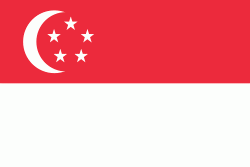Singapore dollar
$
The Singapore dollar (sign: S$; code: SGD) is the official currency of the Republic of Singapore. It is divided into 100 cents. It is normally abbreviated with the dollar sign $, or S$ to distinguish it from other dollar-denominated currencies. The Monetary Authority of Singapore (MAS) issues the banknotes and coins of the Singapore dollar.As of 2019, the Singapore dollar is the 13th-most traded currency in the world by value. Apart from its use in Singapore, the Singapore dollar is also accepted as customary tender in Brunei according to the Currency Interchangeability Agreement between the Monetary Authority of Singapore and the Autoriti Monetari Brunei Darussalam (Monetary Authority of Brunei Darussalam). Likewise, the Brunei dollar is also customarily accepted in Singapore.
The Spanish-American silver dollar brought over by the Manila galleons was in wide circulation in Asia and the Americas from the 16th to 19th centuries. From 1845 to 1939 the Straits Settlements (of which Singapore used to be part of) issued its local equivalent, the Straits dollar. This was replaced by the Malayan dollar, and, from 1953, the Malaya and British Borneo dollar, which were issued by the Board of Commissioners of Currency, Malaya and British Borneo.
Singapore continued to use the common currency upon joining Malaysia in 1963, but only two years after Singapore's expulsion and independence from Malaysia in 1965, the monetary union between Malaysia, Singapore and Brunei broke down. Singapore established the Board of Commissioners of Currency, Singapore, on 7 April 1967 and issued its first coins and notes. Nevertheless, the Singapore dollar was exchangeable at par with the Malaysian ringgit until 1973, and interchangeability with the Brunei dollar is still maintained.
Initially, the Singapore dollar was pegged to the pound sterling at a rate of two shillings and four pence to the dollar, or £1 = S$60/7 or S$8.57; in turn, £1 = US$2.80 from 1949 to 1967 so that US$1 = S$3.06. This peg to sterling was broken in 1967 when the pound was devalued to US$2.40 but the peg to the U.S. dollar of US$1 = S$3.06 was retained. This peg remained for a short time after the Nixon Shock of the early 1970s. As Singapore's economy grew and its trade links diversified to many other countries and regions, Singapore moved towards pegging its currency against a fixed and undisclosed trade-weighted basket of currencies from 1973 to 1985.
Before 1970, the various monetary functions associated with a central bank were performed by several government departments and agencies. As Singapore progressed, the demands of an increasingly complex banking and monetary environment necessitated streamlining the functions to facilitate the development of a more dynamic and coherent policy on monetary matters. Therefore, the Parliament of Singapore passed the Monetary Authority of Singapore Act in 1970, leading to the formation of MAS on 1 January 1971. The MAS Act gave the MAS the authority to regulate all elements of monetary, banking, and financial aspects of Singapore.
From 1985 onwards, Singapore adopted a more market-oriented exchange regime, classified as a Monitoring Band, in which the Singapore dollar is allowed to float (within an undisclosed bandwidth of a central parity) but closely monitored by the Monetary Authority of Singapore (MAS) against a concealed basket of currencies of Singapore's major trading partners and competitors. This, in theory, allows the Singaporean government to have more control over imported inflation and to ensure that Singapore's exports remain competitive.
On 1 October 2002, the Board of Commissioners of Currency Singapore (BCCS) merged with the Monetary Authority of Singapore (MAS), which took over the responsibility of banknote issuance.
Country
-
Singapore
Singapore, officially the Republic of Singapore, is a sovereign island country and city-state in maritime Southeast Asia. It lies about one degree of latitude (137 km) north of the equator, off the southern tip of the Malay Peninsula, bordering the Strait of Malacca to the west, the Singapore Strait to the south, the South China Sea to the east, and the Straits of Johor to the north. The country's territory is composed of one main island, 63 satellite islands and islets, and one outlying islet; the combined area of these has increased by 25% since the country's independence as a result of extensive land reclamation projects. It has the third highest population density in the world. With a multicultural population and recognising the need to respect cultural identities of the major ethnic groups within the nation, Singapore has four official languages: English, Malay, Mandarin, and Tamil. English is the lingua franca and numerous public services are available only in English. Multiracialism is enshrined in the constitution and continues to shape national policies in education, housing, and politics.
Singapore's history dates back at least a millennium, having been a maritime emporium known as Temasek and subsequently as a major constituent part of several successive thalassocratic empires. Its contemporary era began in 1819 when Stamford Raffles established Singapore as an entrepôt trading post of the British Empire. In 1867, the colonies in Southeast Asia were reorganised and Singapore came under the direct control of Britain as part of the Straits Settlements. During World War II, Singapore was occupied by Japan in 1942, and returned to British control as a separate Crown colony following Japan's surrender in 1945. Singapore gained self-governance in 1959 and in 1963 became part of the new federation of Malaysia, alongside Malaya, North Borneo, and Sarawak. Ideological differences, most notably the perceived encroachment of the egalitarian "Malaysian Malaysia" political ideology led by Lee Kuan Yew into the other constituent entities of Malaysia—at the perceived expense of the bumiputera and the policies of Ketuanan Melayu—eventually led to Singapore's expulsion from the federation two years later; Singapore became an independent sovereign country in 1965.
